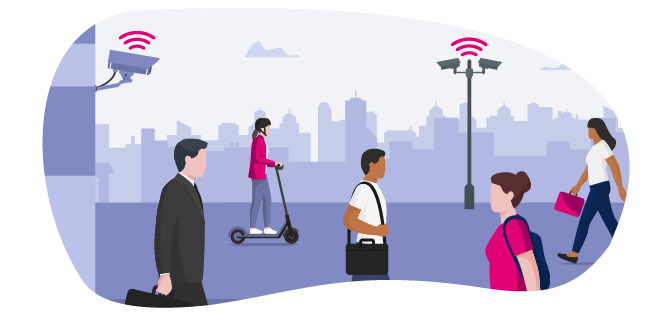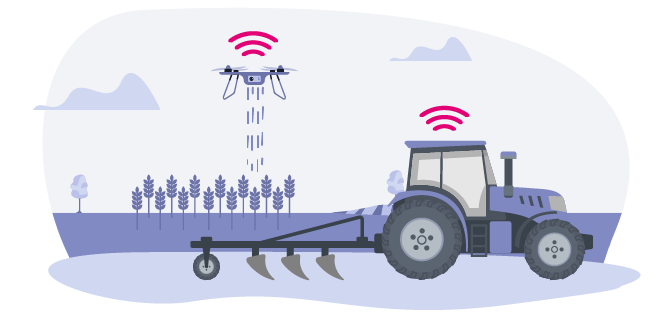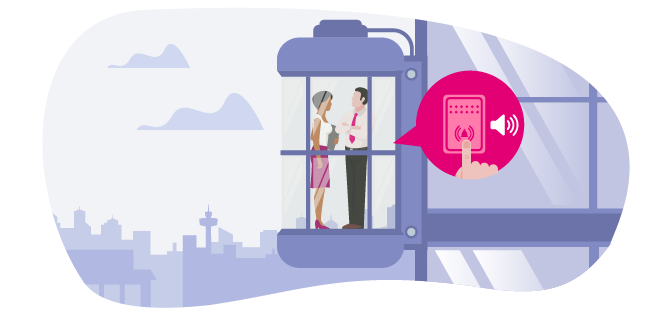
IoT tariffs
The right tariff for every IoT idea
The right tariff for every IoT idea
The right tariff for every IoT idea
The right tariff for every IoT idea
Challenge
Some IoT applications require high data rates: IoT-based surveillance systems can stream high-definition video, which requires high bandwidth. Sensors in vehicles also generate large amounts of data that must be sent in real time over mobile networks.
Solution
In addition to 2G, LTE and LTE-M, our IoT Business Classic and IoT Business Data Best rates also offer 5G as a network technology. This makes maximum data rates of 300 Mbit/s upload and 50 Mbit/s download possible.

Challenge
IoT applications may require devices that operate autonomously over long periods of time: for example, battery-powered IoT sensors for environmental conditions, level sensors in tanks, or trackers that determine the position of goods and assets. These demand the highest energy efficiency for long battery runtimes.
Solution
The IoT Business LPWA tariff uses, among other things, NB-IoT for data transmission. This mobile communications method is extremely energy-efficient, which means that devices can be operated for several years on a single battery charge.

Challenge
Some use cases have an uneven distribution of data usage. For example, smart agricultural machines and drones are needed primarily in the spring and at harvest time, while they are idle in the winter. Data needs can also increase sharply during an application's lifecycle, e.g., due to feature upgrades.
Solution
Our IoT Data Best tariff uses data pools. Three static pool volumes are agreed upon, each with its own monthly price. These pool volumes apply to all SIMs – the individual SIM has no data volume of its own and no minimum contract term. If a data volume is used up, the conditions of the next largest data pool automatically apply. This way, the rate flexibly adapts to your data consumption.

Challenge
IoT sensors may be used in remote regions, where cross-border cellular reception is necessary – for example, when monitoring wind turbines.
Solution
All tariffs in the IoT Business family come with Best Coverage. This enables reliable network coverage for IoT projects in Germany, Europe-wide – even in the case of white spots or network outages. If a mobile IoT device is in a location where Deutsche Telekom has no network, the device automatically dials into the available mobile network of a partner.

Challenge
Typically, IoT tariffs are optimized only for the transmission of data. But for voice control in smart home systems or for emergency call systems – for example in elderly care, healthcare or elevators – a mobile tariff with voice transmission is needed.
Solution
Our IoT tariffs IoT Business Classic and IoT Business Data Best have voice transmission included via the “Voice” option. This allows a speech connection to be established to defined phone numbers.

Which tariff is the most suitable depends primarily on the complexity of your IoT project and the level of customization and service it requires. Telekom offers you various tariffs:
IoT Business Classic
This rate is based on 2G, LTE, LTE-M and 5G network technologies. It is therefore suitable for IoT projects that require a medium to high volume of data. IoT Business Classic uses dynamic data budgets. Thus, each individual SIM in the tariff contributes to the data pool. The available data volume therefore grows and shrinks with the number of SIMs. At the same time, each has a minimum contract term. Since a common data budget is used, differences in data usage between the SIMs thus balance each other out.
IoT Business Data Best
This rate also uses 2G, LTE, LTE-M and 5G network technologies. Like IoT Business Classic, it is thus suitable for IoT projects that require a medium to high data volume. The tariff includes three accumulating data budgets that can be used with a fixed number of SIMs. Only actively used SIMs are taken into account. The individual SIM has no data volume and no minimum contract term. If the largest agreed data budget is exceeded or more SIMs are actively used, automatic top-ups for data volume and SIM ensure the smooth functioning of your applications. This way, the rate flexibly adapts to changes or fluctuations in your data usage.
IoT Business LPWA
This rate supports the NB-IoT mobile communications standard. It is especially suitable for IoT projects in which only a very small amount of data is sent – for example, level sensors in water tanks. In return, NB-IoT offers extremely low energy consumption and maximum building penetration. Annual pooling is used for billing.
We are used to mobile phone contracts for smartphones offering a monthly data volume in sizes upwards of many gigabytes. This is necessary because most of the data traffic consists of image and video data for websites, social media and streaming services.
The IoT tariff IoT Business LPWA, on the other hand, offers a volume of only 6.5 megabytes per month. That's because it's designed for IoT devices that primarily send and receive sensor and control data, which require much less bandwidth. It supports Narrowband IoT (NB-IoT) cellular technology developed for the Internet of Things, which is optimized for range and low power consumption, rather than bandwidth. NB-IoT only allows data transmission of a maximum of 250 Kbit/s – just 0.8 percent of the data rate of a typical DSL connection. This means that this rate can be offered at particularly low cost.
As an international company, Deutsche Telekom operates its own mobile networks in the U.S., Germany and 10 other European countries or holds equity interests in them.
In addition, we enable global access to data connections (data roaming) with our more than 600 selected roaming partners. Telekom's IoT rates provide you with a comprehensive usage zone with a pool of more than 32 countries with a focus on the European region. Additional country groups can be booked as well. The networking of your devices is also ensured outside this pool zone.
All IoT rates include best coverage. If the Telekom network is not available in Germany, your IoT devices can also access the networks of other providers. We also have several roaming partners in most countries worldwide. This way, we always ensure the best connection for your IoT project.
IoT devices are often part of companies' mission-critical processes. If they fail or are compromised by an attacker, major damage can result. Deutsche Telekom has therefore made “security by design” the overriding principle for its IoT platform. The highest security standards apply to the data centers.
Throughout the Group, regular privacy and security assessments ensure the integration of data security and data protection in system and product development. But we don't just provide passive security. As part of our Security Solutions, we offer Fraud Detection as a Service: We actively monitor the usage data of your IoT devices and warn you when irregularities occur – for example, when a car's SIM card logs on from a country in which the vehicle should not be located. Our active and preventive security strategy is already paying off: Deutsche Telekom won the Carrier World Award in the “Best Fraud Strategy” category.
We also offer comprehensive IoT security solutions that not only secure your own networks and certified devices, but also include support from our IoT security experts.